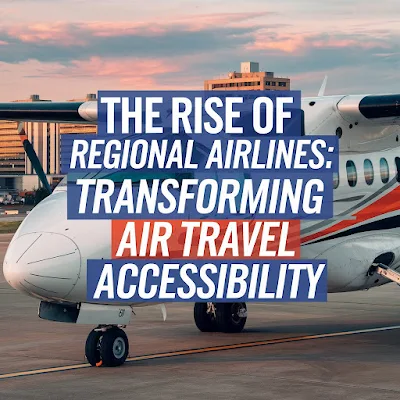The Rise of Regional Airlines: Transforming Air Travel Accessibility
In recent years, the aviation industry has witnessed a remarkable transformation. Regional airlines, often overshadowed by their larger counterparts, are emerging as key players in making air travel more accessible and convenient for passengers. As they expand their reach to underserved areas, these carriers are reshaping the future of air travel.
Regional Airlines: Bridging the Gap in Air Travel
The demand for connectivity in smaller cities and remote regions has spurred the growth of regional airlines. These carriers are strategically filling gaps in the aviation network, providing services where major airlines do not operate. This trend not only benefits passengers but also stimulates local economies by fostering tourism and business opportunities.
Key Features of Regional Airlines:
Smaller Aircraft: Typically operate turboprops or small jets, suitable for short-haul routes.
Frequent Flights: Offer more flexibility with multiple daily flights.
Cost-Effective Operations: Lower overhead costs compared to major airlines, enabling competitive ticket pricing.
Innovations Driving Regional Airline Success
Advancements in technology and business models have been instrumental in the success of regional airlines. From streamlined operations to enhanced customer experiences, these carriers are leveraging innovation to remain competitive.
Fleet Modernization
Regional airlines are investing in fuel-efficient aircraft that reduce operational costs and minimize environmental impact. Modern planes like the Embraer E2 and ATR 72 are tailored for short-haul routes, offering comfort and efficiency.
Digital Transformation
The adoption of digital tools, such as mobile apps for booking and real-time flight updates, enhances the passenger experience. Additionally, data analytics helps airlines optimize routes and pricing strategies.
Partnerships and Codesharing
Collaborations with major airlines allow regional carriers to offer seamless connections to global destinations. Codesharing agreements also improve visibility and ticket sales, benefiting both parties.
Economic Impact of Regional Airlines
The role of regional airlines extends beyond passenger convenience. Their operations contribute significantly to economic development in smaller communities.
Job Creation
Airports in smaller cities see increased activity, leading to the creation of jobs in aviation, hospitality, and ancillary services.
Boost to Local Businesses
Enhanced connectivity attracts business investments and supports local enterprises by improving access to markets.
Tourism Growth
By linking remote areas to larger cities, regional airlines make it easier for tourists to explore hidden gems, boosting the local tourism industry.
Challenges Facing Regional Airlines
Despite their potential, regional airlines face several challenges that could hinder their growth. Addressing these issues is crucial for sustained success.
High Operating Costs
Fuel prices and maintenance expenses can strain budgets, especially for smaller carriers.
Competition with Ground Transport
In regions with efficient train or bus networks, regional airlines must compete on price and convenience.
Regulatory Hurdles
Navigating complex aviation regulations and securing airport slots remain significant obstacles for many regional airlines.
Future Prospects for Regional Airlines
The future of regional airlines looks promising, driven by increasing demand for connectivity and ongoing innovation in the industry. Governments and private stakeholders are recognizing their importance, leading to supportive policies and investments.
Potential Growth Areas:
Sustainable Aviation: Adoption of electric and hybrid aircraft to reduce carbon emissions.
Emerging Markets: Expansion into developing regions with untapped demand.
Customized Services: Tailoring offerings to specific passenger needs, such as chartered flights or premium seating.
Conclusion
Regional airlines are redefining the aviation landscape by bringing air travel to the doorstep of underserved communities. Their role in enhancing connectivity, boosting economies, and fostering innovation cannot be overstated. As these carriers continue to evolve, they are poised to play an even more significant role in shaping the future of global air travel.



0 Comments